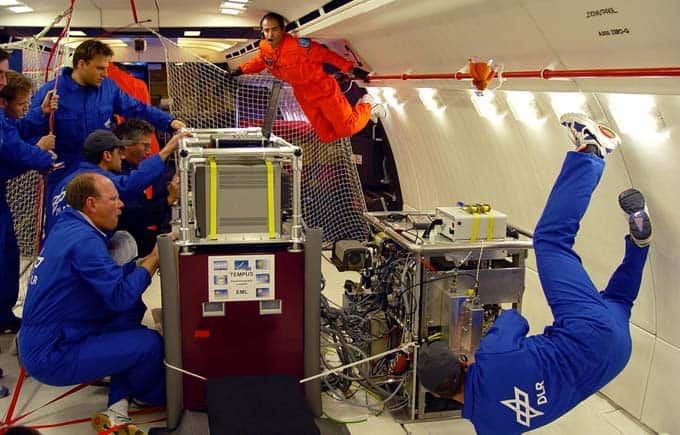Materials research in space with Swiss participation
Empa is conducting materials research in space together with scientists from Ulm and Neuchâtel: super-hard and corrosion-resistant alloys of palladium, nickel, copper and phosphorus - also known as "metallic glasses" - are being studied on the ISS space station. Also on board is a high-tech company from La Chaux-de-Fonds that produces materials for the watch industry.

Metallic glass is similar in color to white gold, but has the hardness of quartz glass. At the same time, it is elastic and resistant to salts or acids. It can be processed in 3D printing, for example for medical implants, or also in injection molding. However, a great deal of materials research still needs to be done before this is possible. At Empa, Antonia Neels, head of the Empa X-ray Center, is working on this mysterious material. Her team is investigating the internal structure of metallic glass using various X-ray methods, thereby discovering correlations with properties such as deformability or fracture behavior. Even for professionals in materials science, metallic glasses are a tough nut to crack: "The closer we look at the samples, the more questions arise," says Antonia Neels. This spurs the researchers' ambition all the more.
Into space for materials research
Now, in a few months, a sample of metallic glass is to fly into space. On the International Space Station ISS, the material properties will be studied in weightlessness. A research group with Empa participation has prepared the samples and registered them with the European Space Agency ESA for space flight. The special alloy is supplied by the PX Group company from La Chaux-de-Fonds, which produces materials for the watch industry and dental technology. The team also includes researchers Markus Mohr and Hans-Jörg Fecht from the Institute of Functional Nanosystems at the University of Ulm and Roland Logé from the Laboratory of Thermomechanical Metallurgy at EPFL in Neuchâtel.
The production of metallic glass is not entirely simple: Compared to window glass, the specially selected metal alloys must be cooled up to a hundred times faster so that the metal atoms do not form crystal lattices. Only when the melt solidifies like a shock does it form a glass. In industry, thin sheets of metallic glass are produced by pressing the melt between rapidly rotating copper rollers. Researchers sometimes cast their samples in molds made of solid copper, which dissipates heat particularly well. But larger, solid workpieces of metallic glass are not feasible with these methods.
The 3D printing helps further
One possible way out of the dilemma is 3D printing using the so-called powder bed process. A fine powder of the desired alloy is heated for a few milliseconds with a laser. The metal grains fuse with their neighbors to form a kind of foil. A thin layer of powder is then placed on top, the laser fuses the freshly applied powder with the underlying foil, and a three-dimensional workpiece is gradually created from many briefly heated powder grains.

This method requires a fine dosage of the laser pulse. If the laser burns too weakly on the powder, the particles do not fuse together and the workpiece remains porous. If the laser burns too strongly, it also melts the lower layers again. The multiple melting allows the atoms to rearrange themselves, forming crystals - and that's the end of metallic glass.
Tracking down the secrets with X-ray methods
At Empa's X-ray center, Antonia Neels' team has already analyzed several such samples from 3D printing experiments. The results, meanwhile, always raise new questions. "Some evidence suggests that the mechanical properties of the glasses do not deteriorate, but on the contrary actually improve, if the sample contains small crystalline fractions," says Neels. "Now we are looking into the question of how large this crystal fraction in the glass has to be, and what kind of crystals have to form to increase, for example, the pliability or impact strength of the glass at room temperature."
To track down crystal growth in an otherwise amorphous environment, Empa's experts use various X-ray methods. "With radiation of different wavelengths, we can learn something about the structure of the crystalline parts, but also determine close-order phenomena of the atoms in the sample - in other words, determine the properties of the chemical bonds," explains Neels. In addition, X-ray imaging analysis, known as micro-CT, reveals something about density fluctuations in the sample. This indicates phase segregation and crystal formation. However, the density differences between the glassy and crystalline regions are minute. Therefore, detailed image processing is needed to visualize the three-dimensional distribution of the crystalline portions.
Why material research in weightlessness?
Materials research to date using 3D methods has its limitations. Above all, the question of the temperatures at which the aforementioned crystals form and how they grow still needs to be clarified. Thermo-physical parameters such as viscosity or surface tension play a role here. Experiments on the ISS offer ideal conditions for their analysis. In order to test the behavior in weightlessness, the first droplets of metallic glass were brought into suspension on an experimental basis as early as 2019, on board an Airbus A310, which carried out a so-called parabolic flight. In the experiment called TEMPUS (crucible-free electromagnetic processing under zero gravity), the glass droplet consisting of palladium, copper, nickel and phosphorus was held in suspension by means of a magnetic field and heated up to 1500 degrees Celsius by induction. During the cooling phase, two short pulses of induction current caused the glowing droplet to oscillate. A camera recorded the experiment. After landing, the material sample was analyzed at Empa's X-ray center. However, since more in-depth analyses require a longer duration of weightlessness than that possible on a parabolic flight, a material sample has now been registered for a flight in the European COLUMBUS module of the ISS. The ISS-EML electromagnetic levitation furnace has been installed there since 2014. In each case, 18 material samples fly along, are automatically exchanged and can be observed by researchers on Earth via video stream. The metallic glass from Switzerland will go into space with the next batch of samples.
Computer simulation for new casting processes
From the far more detailed data of the space flight, the researchers want to generate a computer simulation of the melt. This will bring all the answers together in a unified model through a combination of experiments on Earth and in space: At what temperature is there what viscosity and surface tension? When do crystals of what composition, size and orientation form? How does this internal material structure influence the properties of the metallic glass? From all these parameters, the researchers want to develop a manufacturing method together with the industrial partner PX Group, in order to be able to produce the coveted material in a defined form. In the next few years, therefore, there is still plenty to do for the materials researchers in all the teams involved.
Source and further information: Empa









